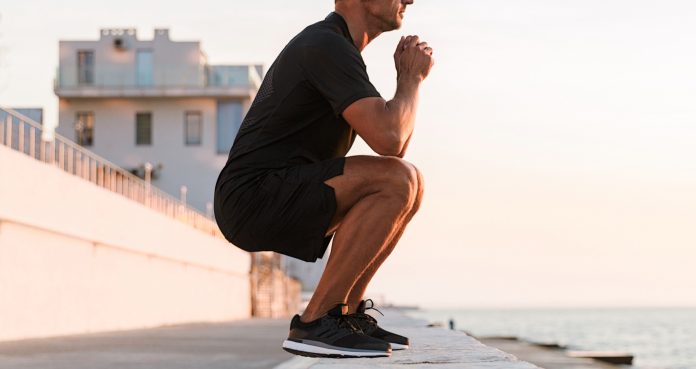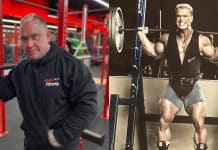
The belt squat front-loads the quads more, placing less stress on your lower back than back squats.
Squats are a fundamental movement that dramatically improves performance and minimizes injury risks (1). While back squats are the commonly favored squat variation and are highly impactful, they exert significant pressure on the spine, which can pose challenges, particularly for individuals experiencing lower back pain. Enter the belt squat and other variations, such as the landmine squat.
Louis Simmons developed belt squats, also known as hip belt squats, to solve this issue. He aimed to replicate the traditional back squat motion while minimizing the strain on the lower back. With the introduction of belt squats, he successfully achieved his goal. Research indicates that while belt squats engage most leg muscles similarly to back squats, they impose less stress on the stabilizing muscles of the core, particularly the lower back (2).
They’re excellent for continuing to train your legs with significant loads when your back is not at its best. However, it’s crucial to master the correct form for this routine. This comprehensive exercise guide provides instructions on performing them correctly and explores various other variations you can incorporate into your workout routine.
Techniques and Muscles Worked
Belt squats work on your quads, glutes, hamstrings, and calves. They’re more quad-focused than regular back squats because the loading occurs at your hips. While belt squats also activate core muscles like the abs and obliques, they do so significantly less than the regular back squat.
To do them, you must wear the belt properly first. Ensure that you attach both ends relatively snugly and high. You should also avoid using the entire chain length as you need some distance between the floor and them to get a full range of motion. Then, follow the step-by-step guide below.
- Wrap the belt above your hips to connect it to the cable, and once connected, guide the belt to rest on your hips.
- Use the handles to guide yourself to a standing position. You should be standing directly over the machine’s pulley, and your legs should be shoulder-width apart, with your toes facing out. This is your starting position.
- Next, drop down to a squatting position by sitting back with your hips. You’ll be in proper form if you focus on sitting back and allow the belt to pull you down.
- Drop down until you reach the proper depth for a full range of motion, then pause.
- Power back up to return to the starting position and complete the rep.
- Repeat for the number of reps you desire.
Belt Squat Benefits
Belt squats are an excellent way for those with specific injuries to continue training their lower body. However, they also offer a host of other advantages. Below are some of the benefits you’ll reap with this exercise.
Quad Muscle Hypertrophy
Studies into the muscle activations of the back squat and belt squat show that both exercises emphasize your glutes and other lower body muscles differently (3). For this exercise, the emphasis is on the quads due to the placement of the belt on your hips. This leads to more significant loading of your quads and more muscle growth.
Less Stress on the Lower Back
They have no axial loading, which means less stress on your lower back. This offers an advantage to those with lower back pain or injuries. It can also be helpful if you’ve already been loading your back muscles and they’re tired.
Better for Those with Shoulder Mobility Problems
Back squats require significant shoulder mobility. As a result, this exercise could be challenging for those with shoulder injuries or mobility issues. The weight sits on your hips during belt squats, which removes shoulder mobility problems.
Effective for High-Volume Training
High-volume training is a great way to sculpt and build your lower body muscles. However, when other body muscles like the back get involved, as with the back squat to support the load, you’re limited. Different muscles will tire faster, so you must stop to avoid injuries. With belt squats, the load is on your lower body only, so you can comfortably do high-volume training for longer.
Machine Versatility
They’re highly versatile, and you can use multiple variations of this exercise to target your muscles differently. You can use the belt machine to do these many variations, too. Squats are also one of many routines you can do with this machine.
Variations
Speaking of versatility, below are some other variations you can try out.
Belt Split Squats
This movement is a unilateral exercise that will challenge your lower body. It hits your legs one at a time and is excellent for your stability. They also help you find and fix any muscle imbalance between your legs.
Belt Marches
This is a functional exercise that simulates walking in place with a load. It activates your glutes with additional stimulus to your hip flexors. They’re great for those training to walk under heavy loads without injuring their back.
Belt Squat Romanian Deadlifts
You can also do a variation with deadlifts. The belt squat with Romanian deadlift is a variation combining both advantages. However, it doesn’t target the muscles as effectively as a conventional deadlift.
Landmine Belt Squats
The landmine belt squat is many gym goers’ favorite belt squat variation. As the name suggests, they require a landmine setup.
FAQs
What is it good for?
This exercise is a great way to train your leg muscles without involving your lower back. It’s also an excellent alternative for people with shoulder mobility issues.
Is it better than the leg press?
The belt squat and leg press build your hips and glutes without targeting your upper body muscles. However, the belt squat reduces spinal loading more than the leg press.
How do you do them?
You must load up the machine and set the belt on your hips to do them. Then, you can proceed to squat. For step-by-step instructions, check the exercise guide above.
Follow us on Instagram, Facebook, and Twitter for more exercise guides!
References
- Myer, G. D., Kushner, A. M., Brent, J. L., Schoenfeld, B. J., Hugentobler, J., Lloyd, R. S., Vermeil, A., Chu, D. A., Harbin, J., & McGill, S. M. (2014). The back squat: A proposed assessment of functional deficits and technical factors that limit performance. Strength and conditioning journal, 36(6), 4–27. https://doi.org/10.1519/SSC.0000000000000103
- Joseph, L., Reilly, J., Sweezey, K., Waugh, R., Carlson, L. A., & Lawrence, M. A. (2020). Activity of Trunk and Lower Extremity Musculature: Comparison Between Parallel Back Squats and Belt Squats. Journal of human kinetics, 72, 223–228. https://doi.org/10.2478/hukin-2019-0126
- Evans, T. W., McLester, C. N., Howard, J. S., McLester, J. R., & Calloway, J. P. (2019). Comparison of Muscle Activation Between Back Squats and Belt Squats. Journal of strength and conditioning research, 33 Suppl 1, S52–S59. https://doi.org/10.1519/JSC.0000000000002052















